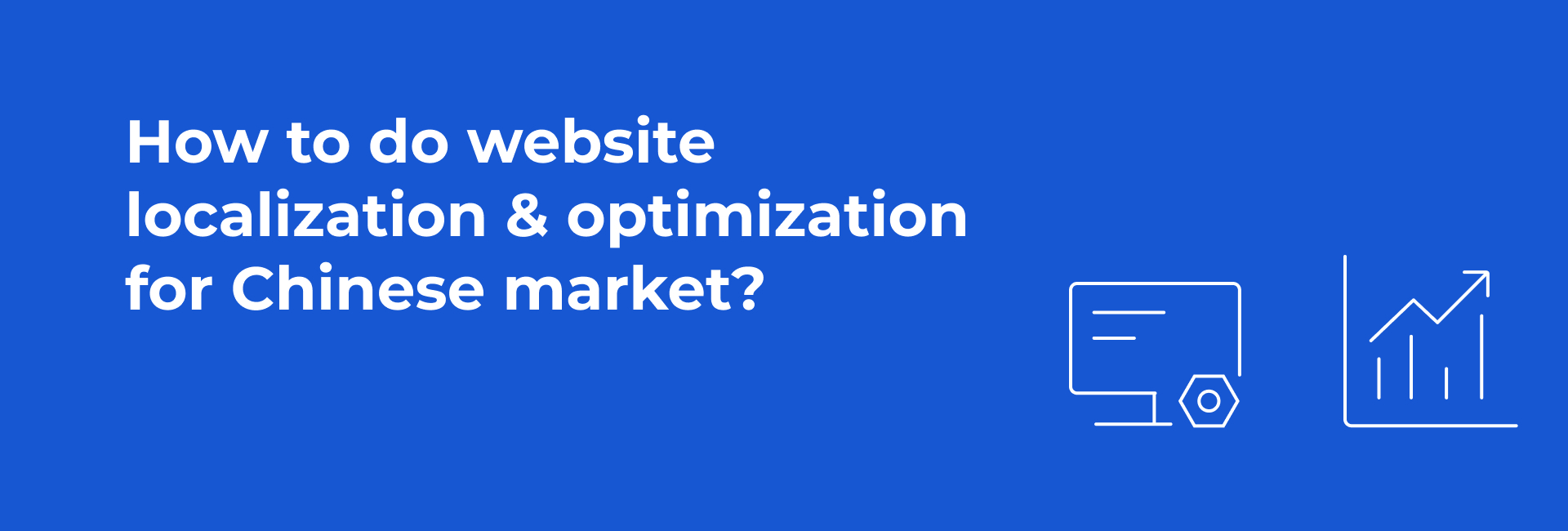Submit your project
Get a free quote
Website Localization in China
If you are planning to expand into the Chinese market, you must localize your website. To localize an existing website requires an understanding of cultural differences and technical issues which is uncommon in the western market. This article will share you with the guidance of website localization covering hosting, ICP registration, UI / UX and technical adaption.
Why should company host services in China?
Loading speed
Chinese visitors’ expectation regarding website loading speed is very high, if website’ s loading speed is too low, the potential clients may leave for their competitors. Thus, company may risk the decline of the business conversion rate.
Improve brand awareness
Local Chinese users tend to trust more easily to the websites that are from within China.
Website stability
A website hosted outside of China could be quite unstable for users in China.

How to host your website in China?
hosting provider
Some well-known hosting provider : Alibaba Cloud Tencent Cloud xinnet新网, west西部数码, CNDNS 美橙互联, 22爱名网, AWS, Azure
Purchase domain
Book under Chinese entity from a local provider, but if a company wants to use existing domain that booked out of China, they need transfer to china mainland.
ICP Registration
| ICP filling | ICP commercial License | EDI | |
|---|---|---|---|
| When needs it | Before your Chinese hosted website or platform go live. | Applicants must first apply for an ICP Filing |
Applicants must first apply for an ICP Filing |
| Who needs it | Non-commercial Internet information services | Commercial Internet information services |
Web platforms processing online data and transactions “C2C” (Customer-to-customer) and “O2O” (Online-to-offline) |
| Who can apply | Individual and corporate applicants |
- With a commercially registered business entity in Mainland China. - Locally owned Chinese companies and Joint Ventures where the foreign partner has less than 50% ownership. - Representative Offices (RO) are not eligible - Wholly Foreign Owned Enterprises (WFOEs) are also not eligible |
Marketplaces that have multiple vendors directly selling goods and services on a web platform, as opposed to one vendor selling their products from an e-commerce website. |
| Scenario |
A retailer or a university operating a website that produces marketing content but does not provide any ecommerce functionalities. |
A retailer that is marketing and selling directly via an online payment gateway such as Alipay or Wechat Pay. | Taobao or Tmall where the platform facilitates transactions between multiple independent vendors and customers. |
| Processing time | 30 days | 60-90 days | 60 working days |
Adapt UI / UX
To achieve the best results in China, it is important to understand cultural and user behavior differences. This can be assisted by web designers with a firm grasp on the local market and a good sense of successful web design in China.

Video Clips on Homepage
It is widely known that Internet users prefer to watch videos instead of reading content. Images are easier to follow, more entertaining, and can stir emotions more effectively.
A video added to the homepage up to 20 seconds should already be enough. If used insightfully, videos will increase the time users spend on your page, giving you more opportunities to generate conversions.
Minimalistic design
Since 2018 we have seen an increase in minimalistic web design in China. Many businesses are following the pattern set by some big companies such as Lenovo who has redesigned their platform with a minimalistic approach.
Even though the overall design is minimalistic, hyperlinks and previews must be more descriptive than in the western world to instill confidence in the user and provide them with the experience that they are looking for.
Easy navigation
The design should be implemented in a way to give direct access to as much information as possible. This can be done by creating multiple levels of navigation that redirect to shorter web pages. Moreover, navigation menus must be organized not vertically but horizontally as the horizontal structure is easier to scan in the Chinese language.
Mobile first

Responsive design is now a priority in web design. This design method enables web to fit the screens of different devices automatically, displaying the content in a way that people feel comfortable.
According to the Internet Network Information Center’s (CNNIC) Statistic Report on Internet Development in China (2022). The proportions of Chinese netizens accessing the Internet through mobile phones, desktop computers, laptops computers, TVs and tablet computers were 99.6%, 33.3%, 32.6%, 26.7% and 27.6%, respectively.
Therefore, having a mobile-responsive website for China is not just good practice – it is an absolute necessity if you are serious about breaking into the Chinese market.

Technical Adaption
Page Speed Optimization
A fast website does not happen overnight. It is the result of a deep analysis of your website's performance and the implementation of several tools that will boost that performance. Below is the quick checklist that you need take into consideration:
- Have your website hosted in China
- Improve page performance: fewer http requests, cookie free domains, avoid url redirects, empty src or href, load JS at bottom etc.
- Optimize content type : images, font, scripts, css and HTML.
- Consider using a CDN service that not blocked in China

Avoid Blocked APIs & 3rd party services
Chinese website localization strategy must include an analysis of which APIs are blocked in the country and substitute them with those that work in China.
For example:
- Replace certain social-media channels and services with Chinese counter-parts. Weibo instead of Twitter, Bili Bili or Youku instead of YouTube videos.
- Replace Google maps with Baidu or Tencent map, and Google fonts and tags with Chinese ones as well.
- Replace CDN that are blocked in China.
















